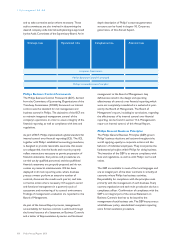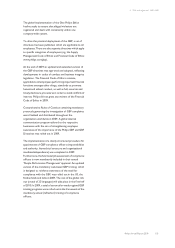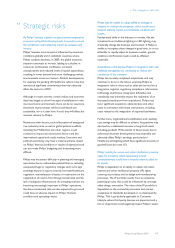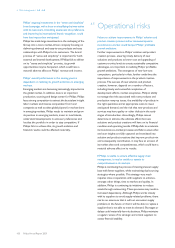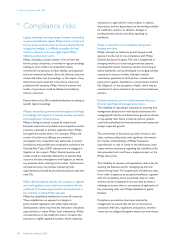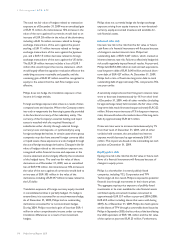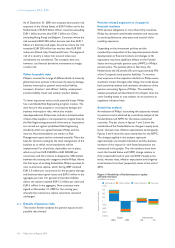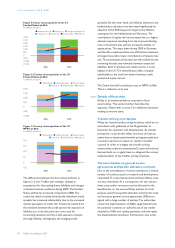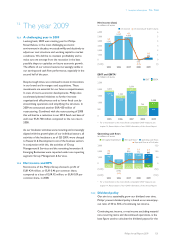Philips 2009 Annual Report Download - page 113
Download and view the complete annual report
Please find page 113 of the 2009 Philips annual report below. You can navigate through the pages in the report by either clicking on the pages listed below, or by using the keyword search tool below to find specific information within the annual report.
normally be satisfied through the Commercial Paper
Program. Additionally EUR 357 million of investments in
its available-for-sale financial assets and listed equity-
accounted investees (fair value at December 31, 2009)
were available. Furthermore, Philips had a committed
undrawn bilateral loan of EUR 200 million. As of
December 31, 2009 Philips did not have any loans
outstanding under any of these facilities.
On Febuary 18 , 2010 Philips signed a new 5-year EUR 1.8
billion revolving credit facility to replace the existing USD
2.5 billion facility.
Currency risk
Currency risk is the risk that the fair value or future cash
flows of a financial instrument will fluctuate because of
changes in foreign exchange rates. Currency fluctuations
may impact Philips’ financial results. Philips is exposed to
currency risk in the following areas:
• Transaction exposures, related to forecasted sales and
purchases and on-balance-sheet receivables/payables
resulting from such transactions
• Translation exposure of net income in foreign entities
• Translation exposure of foreign-currency
intercompany and external debt and deposits
• Translation exposure of foreign-currency-denominated
equity invested in consolidated companies
• Translation exposure to equity interests in non-
functional-currency equity-accounted investees and
available-for-sale financial assets.
It is Philips’ policy that significant transaction exposures
are hedged by the businesses. Accordingly, all businesses
are required to identify and measure their exposures
resulting from material transactions denominated in
currencies other than their own functional currency.
Philips’ policy generally requires committed foreign
currency exposures to be fully hedged using forwards.
Anticipated transactions may be hedged using forwards or
options or a combination thereof. The amount hedged as
a proportion of the total exposure identified varies per
business and is a function of the ability to project cash
flows, the time horizon for the cash flows and the way in
which the businesses can adapt to changed levels of
foreign-currency exchange rates. As a result, hedging
activities may not eliminate all currency risks for these
transaction exposures. Generally, the maximum tenor of
these hedges is 18 months.
The following table outlines the estimated nominal value
in millions of euros for transaction exposure and related
hedges for Philips’ most significant currency exposures as
of December 31, 2009:
Estimated transaction exposure and related hedges
in millions of euros
maturity 0-60 days maturity over 60 days
exposure hedges exposure hedges
Receivables
GBP vs. EUR 50 (46) 212 (120)
PLN vs. EUR 34 (30) 83 (50)
USD vs. EUR 473 (408) 1,186 (844)
USD vs. CNY 4 (4) − −
EUR vs. USD 115 (98) 616 (330)
JPY vs. EUR 26 (28) 134 (116)
EUR vs. CNY 4 (3) 24 (17)
Others 216 (218) 592 (333)
Payables
USD vs. BRL (58) 34 (137) 62
PLN vs. EUR (43) 34 (152) 84
USD vs. EUR (660) 507 (1,052) 590
EUR vs. CNY (1) 1 (35) 19
CNY vs. USD (52) 52 (143) 76
MYR vs. USD (8) 5 (34) 13
Others (273) 177 (419) 231
The first currency displayed is the exposure that is being hedged followed by the
functional currency of the hedging entity.
The derivatives related to transactions are, for hedge
accounting purposes, split into hedges of on-balance-
sheet accounts receivable/payable and forecasted sales
and purchases. Changes in the value of on-balance-sheet
foreign-currency accounts receivable/payable, as well as
the changes in the fair value of the hedges related to these
exposures, are reported in the income statement under
income from operations. Hedges related to forecasted
transactions, where hedge accounting is applied, are
accounted for as cash flow hedges. The results from such
hedges are deferred in other comprehensive income
within equity to the extent that the hedge is effective. As
of December 31, 2009, a gain of EUR 10 million was
deferred in equity as a result of these hedges. The result
deferred in equity will be released to earnings mostly
during 2010 at the time when the related hedged
transactions affect the income statement. During 2009, a
net gain of EUR 7 million was recorded in the income
statement as a result of ineffectiveness of cash flow
hedges.
6 Risk management 6.7.2 - 6.7.2
Philips Annual Report 2009 113



